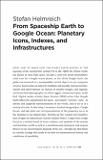From Spaceship Earth to Google Ocean: Planetary Icons, Indexes, and Infrastructures
Author(s)
Helmreich, Stefan
Downloadspaceship google ocean.pdf (452.9Kb)
PUBLISHER_POLICY
Publisher Policy
Article is made available in accordance with the publisher's policy and may be subject to US copyright law. Please refer to the publisher's site for terms of use.
Terms of use
Metadata
Show full item recordAbstract
What sort of image does the planet Earth possess at the opening of the 21st century? If in the 1960s, the Whole Earth, the planet as seen from space, became a cold war, proto-environmentalist icon for a fragile ocean planet, in the 2010s, Google Earth, the globe encountered as a manipulable virtual object on our computer screens, has become an index for multiple and socially various interpretations and interventions; its thicket of satellite images, text legends, and street level photographs can all be tagged, commented upon, modified. In this essay, I examine a kindred image-object, Google Ocean, asking what sort of representation of the planetary sea is in the making in our digital days. Stirring up the century-old classification of signs by semiotician Charles Sanders Peirce, I argue that Google Ocean is a mottled mash of icons, indexes, and symbols of the marine and maritime world as well as a simultaneously dystopian and utopian (that is to say, heterotopian) diagram of the sea - though one that floats in a media ecology that tends to occlude its infrastructural history and conditions of possibility.
Date issued
2011-01Department
Massachusetts Institute of Technology. Anthropology ProgramJournal
Social Research
Publisher
Graduate Faculty of Political and Social Science, New School University
Citation
Helmreich, Stefan. "From Spaceship Earth to Google Ocean: Planetary Icons, Indexes, and Infrastructures." Social Research 78.4 (Winter 2011): 1211-1242.
Version: Final published version
ISSN
0037-783X
1944-768X